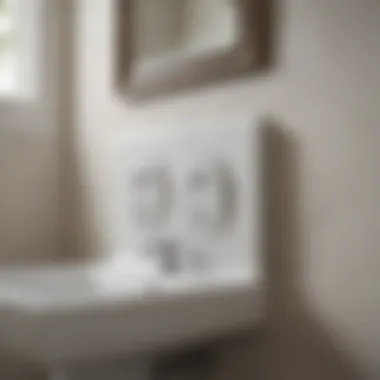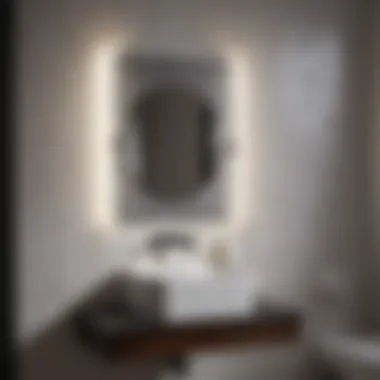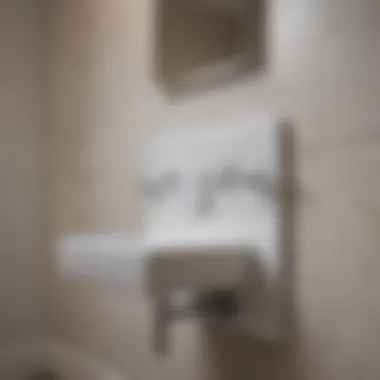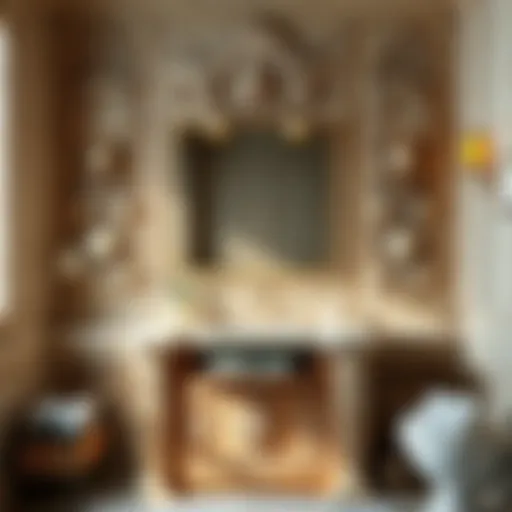Bathroom Vanity Electrical Outlet Placement Guide


Intro
When it comes to bathroom renovations, one of the less glamorous but crucial elements to consider is the location of electrical outlets, especially around bathroom vanities. Though it might not come up in typical conversations about aesthetics and style, proper outlet placement can make or break the functionality and safety of this often-used space.
In this guide, we'll tackle the best practices and considerations for electrical outlet placement in bathrooms, ensuring that you not only comply with safety regulations but also maintain an appealing design. You might be wondering why this matters—after all, aren’t all bathrooms more or less the same? Well, a thoughtful approach to outlet placement can enhance everyday habits, warm up the overall atmosphere, and keep safety at the forefront of your mind.
Trending Styles
Modern Minimalism
In a world where space is often at a premium, many homeowners are turning to modern minimalism. This style emphasizes clean lines and simplicity, making it a perfect fit for small bathrooms or intimate settings. When thinking about outlet placement in a minimalist bathroom, limitations in clutter should reflect in the design of the outlets themselves.
Choose sleek, flush-mounted outlets that blend seamlessly with the wall. You might even consider installing outlets inside a cabinet, so they’re hidden from view yet accessible when you need them. This approach not only maintains a tidy look but also reinforces the minimalist ethos of functionality without excess.
Cozy Rustic
On the flip side, cozy rustic bathrooms evoke warmth and a sense of comfort. Wood accents, natural textures, and earthy color schemes characterize this style. Here, the placement of electrical outlets should harmonize with the rustic feel.
Think about integrating electrical outlets into wooden cabinetry or wall panels to create a cohesive look. This can be especially effective in areas where practicality meets style, such as beside the sink or near decorative elements like potted plants or vintage accessories.
Color Palettes
Calming Neutrals
When considering electrical outlet placement, the overall color scheme of your bathroom is key. Calming neutrals—like soft whites, greys, and beige—are favored for their ability to instill a tranquil atmosphere. Here, outlets should be in colors that blend with or complement the wall colors, ensuring they do not break the serene vibe.
However, don’t shy away from using textured finishes or unique shapes that echo other design elements. This subtle interplay can make an everyday outlet a standout feature without drawing too much attention.
Bold Accents
Conversely, incorporating bold accents can bring energy to your bathroom space. If your bathroom features strong colors or vibrant patterns, consider strategically placing outlets in key locations that don’t interfere with focal points. You might want to paint outlet covers in colors that pop or choosing playful styles, like retro designs, to match your vibrant palette.
Using different outlet styles in various sections of the bathroom can enhance the theme further, ensuring usability while keeping visual excitement high.
"Strategically placed outlets not only serve practical functions but can also complement your aesthetic choices, resulting in a bathroom that feels effortlessly stylish."
By maintaining a keen eye on trends and styles, you can optimize your bathroom’s electrical outlet placement while ensuring everything is functional and visually appealing. After all, a well-planned bathroom is a step towards a more organized home—so let's ensure your outlets are as thoughtfully placed as they are stylish.
Understanding Electrical Safety in Bathrooms
When it comes to bathrooms, electrical safety is paramount. It's not just about having functionality; it's also about ensuring that the elements we introduce into this moisture-rich environment keep us safe. Every homeowner must recognize the unique hazards posed by water and electricity working in close proximity. Getting this balance right is crucial for creating a safe bathroom space and preventing potential accidents.
Overview of Electrical Codes
Electrical codes are put into place to protect individuals and property from the dangers presented by electrical installations, particularly in areas like bathrooms where water and electricity interact. These codes, regulated by standards set forth in national and local jurisdictions, provide essential guidelines about where and how to install outlets.
Some key considerations include:
- Proximity to Water Sources: Outlets must not be located too close to bathtubs, sinks, or showers. Typically, they should be at least three feet away from these fixtures.
- Minimum Height Off The Ground: Installing outlets at least 15 inches off the ground is usually a good practice to prevent accidental splashes from sinks or tubs.
- Use of GFCIs: Most building codes mandate that outlets in bathrooms be equipped with Ground Fault Circuit Interrupters (GFCI). These devices are designed to trip and cut power when they detect abnormal current flow, thereby reducing the risk of electrocution.
Familiarizing oneself with these codes can prevent not only legal violations but also potential hazards that could arise from improper installations.
Ground Fault Circuit Interrupters (GFCI)
Ground Fault Circuit Interrupters, or GFCIs, are a crucial component of bathroom electrical safety. These outlets are designed specifically to protect against electrical shock, making them a necessary fixture in any bathroom setup.
How GFCI Outlets Work: A GFCI constantly monitors the flow of electricity through the circuit. If it detects a discrepancy – for instance, when electricity is leaking somewhere, such as through a person who has accidentally made contact with water – it trips, cutting off power in as little as a fraction of a second.
The benefits of using GFCI outlets include:
- Enhanced Safety: They significantly reduce the risk of electrical shock in wet conditions.
- Legal Compliance: Many electrical codes make GFCI outlets mandatory in new construction or major renovations. Failing to comply can lead to fines and dangerous situations.
- Reliability: Most GFCIs are designed to self-test, meaning they can notify you if they need to be replaced.
Incorporating GFCIs in your bathroom is not a luxury; it’s a necessity. This added layer of safety should not be overlooked during any bathroom renovation or build.
Remember: Always prioritize compliance with electrical safety regulations in your bathroom. It can mean the difference between a safe environment and one prone to risk.


Evaluating Your Bathroom Layout
When it comes to electrical outlet placement in bathroom vanities, one cannot overlook the importance of evaluating your bathroom layout. This step lays the foundation for a practical and safe electrical setup. Understanding how your space flows, where the natural light comes from, and the overall layout can guide you in determining the best locations for outlets. Let’s dive deep into the components that matter in execution.
Space Planning for Vanities
Space planning is more than just figuring out where the vanity will stand. It’s about foresight, envisioning how the bathroom will function day-to-day. You might have a tiny nook or a sprawling area, but every inch counts. Imagine how you interact with the space: where do you store the essentials? Is there sufficient room to move about? These considerations are pivotal.
You want to think about how close your outlets are to the vanity area, sinks, and any other necessary appliances, such as hair dryers or electric razors. Generally, it’s a good call to have outlets near areas where you might need them most – like at or above the countertop. This also helps in reducing the risk of running extension cords through damp areas, which is a definite safety hazard.
Additionally, ensuring adequate clearances around the vanity is essential. It aids in keeping the functionality at its peak while considering safety and convenience. If you have a larger vanity, think about the number of outlets needed. Too few can lead to overcrowding with cords around the sink area, which is not just messy but can also be dangerous. Another point worth noting is the height of the outlet. It is typically recommended to place outlets around 18 inches above the floor, but adjustments might be necessary based on the specific features of your vanity.
Assessing Nearby Fixtures
Now, let’s chat about assessing nearby fixtures. This notion cannot be stressed enough. When planning outlet placements, it's vital to consider existing and potential fixtures in the vicinity. For instance, if you have lighting fixtures, consider how they may influence outlet needs and placement.
Keep an eye on where your light bulbs and mirrors reside, and think about their respective distances from your vanity. For instance,
- Wall-mounted lighting often encourages outlets set higher on the wall to keep cords out of sight, ensuring a neat appearance.
- Mirrors may dictate where you want to use electric shavers or illuminated mirrors, nudging you toward strategic placements nearby.
Don’t overlook plumbing fixtures as well – water sources need cautious attention. Outlets should not be positioned directly above any sinks, given the percussion of water splashes. The National Electrical Code recommends maintaining a distance of at least six feet away from any wet areas. Take a moment to assess how bathroom functions will correspond with the electrical needs and adjust your outlet plans accordingly.
In summary, evaluating your bathroom layout is a stepping stone in designing an efficient electrical setup. By planning the space wisely and thinking critically about nearby fixtures, you create an environment that is not only functional but also safe.
Choosing Outlet Locations
Choosing the right locations for electrical outlets around your bathroom vanity is not just a matter of convenience but also pivotal to ensuring safety and usability. Outlets need to be positioned thoughtfully to avoid potential hazards while maximizing functionality. With the rise of beauty gadgets, devices for personal care, and smart technology, identifying suitable outlet placements will significantly enhance the user experience.
Standard Height Guidelines
When determining the height for outlet placement, it's essential to strike a balance between accessibility and safety. The typical standard height for outlets in a bathroom aisle is around 20 to 24 inches above the floor. This height aligns well with the average height of bathroom vanities, making it practical for reaching and plugging in devices without stretching or bending excessively.
However, as bathroom designs evolve, some homeowners might prefer custom heights based on specific needs. For example, if you have a higher vanity, consider raising the outlets accordingly. This adjustment helps avoid any potential water exposure or spills that can occur at a lower height.
Proximity to the Vanity
The proximity of electrical outlets to the vanity is a crucial factor that cannot be overlooked. Ideally, outlets should be located within easy reach of the vanity area, especially if devices like hairdryers, straighteners, or shavers are regularly used. Having them too far can be frustrating and, in some cases, dangerous if the cords must stretch across wet areas.
A recommended practice is to place outlets between the sink and the mirror. This placement offers easy access while reducing the chance of electrical hazards. For those willing to venture beyond conventional wisdom, installing a couple of outlets on either side of the vanity can provide ample options for multiple appliances, providing that space allows it.
Use Cases for Electrical Outlets
Understanding the various use cases for electrical outlets in the bathroom is key to effective placement. Commonly utilized appliances include:
- Hair Dryers: They typically need to be plugged in for long durations. Hence, having an outlet nearby should be a priority.
- Electric Razors: These devices often require charging and need to be easily accessible without the risk of falling into water.
- Electric Toothbrushes: Many people prefer to charge them at the vanity station, thus necessitating an outlet near the sink.
While these are the typical uses, modern advancements also pave the way for other gadgets. Smart mirrors, for instance, can add a touch of luxury and function to your bathroom. A strategically placed outlet can turn a basic bathroom into a more versatile space conducive to personal grooming.
Remember: Installing multiple outlets can save a fair bit of hassle. If you can, include USB ports in your plans. They tend to double the efficiency of your setup, accommodating more devices, particularly smartphones or tablets that often accompany morning routines.
Design Considerations
Design considerations play a significant role when it comes to placing electrical outlets in a bathroom vanity setup. It’s not just about functionality and safety; the visual appeal of your bathroom hinges on harmonizing functionality with aesthetics. If electrical outlets are poorly placed or detract from the overall design, they can be an eyesore, throwing a wrench in the entire decor scheme.
Successful outlet design incorporates strategic placement and an overall understanding of the bathroom's aesthetic. The key objectives are enhancing usability, ensuring safety, and keeping the visual appeal intact. Homeowners need to think critically about how outlets will interact with the spaces around them. An outlet nestled awkwardly could clash with the elegant lines of a sleek vanity or modern fixtures.
Incorporating thoughtful designs can invite both elegance and convenience:
- Strategic Placement: Outlets should never take center stage but rather blend into the surroundings. Consider placing them at the back of the vanity or tucked into the sides to keep them discreet yet accessible.
- Color Matching: Outlets in a contrasting color can seem like they crash the party rather than join it. Choosing colors that match your walls or cabinetry can make them almost invisible, achieving that cohesive look.
- Functionality Meets Foolproof Design: Doesn’t matter how good it looks if it doesn’t work well. Outlets must still adhere to all electrical regulations while being easily accessible for appliances like hairdryers or electric razors.
The careful balancing act between aesthetic appeal and practical utility is crucial in a bathroom. Your vanity design should whisper professionalism and elegance while the electrical outlets discreetly influence ease of use and safety.
Blend with Bathroom Aesthetic
When thinking about blending with bathroom aesthetics, the goal is to create a seamless look. Beauty isn't in the in-your-face design but in the details that ensure the room feels unified. This means carefully considering the materials and colors of the outlet covers and how they play with the overall color palette of the bathroom.


- Material Matters: Different materials can either fit or clash with your vanity. A chrome outlet cover might work wonders in a modern space, while a brushed nickel could suit a more traditional style. Your outlets should feel like a natural extension of your design elements.
- Height and Positioning: Installing outlets at eye-level can disrupt visual lines. Lower placements can minimize visibility, making them less obtrusive while still functional.
In short, the better the integration of your outlets with the overall bathroom design, the more inviting your space will feel.
Use of Decorative Outlet Covers
Using decorative outlet covers isn't just about making things look pretty - it’s a practical choice that can elevate your vanity without much hassle. Think of these covers as the jewelry of your bathroom’s electrical fixtures. They should enhance your design while complying with safety standards.
- Fun Designs: There are countless options, from ornate styles that evoke classic elegance to sleek modern lines that offer a minimalist feel. Choosing the right cover can draw the eye and distract from what could otherwise become an unappealing focal point.
- Easy to Switch: Switching out outlet covers is a simple task that can make a big impact. If your styles change or if you want to freshen up the look, a new cover can give your bathroom a face-lift without the need for extensive renovations.
- Functional Design: Some outlets come with built-in USB ports, which can be incredibly convenient. These combination covers not only fit the aesthetic but also add functionality that aligns with modern needs.
By considering decorative outlet covers, homeowners can effortlessly align electrical functionality with a commitment to design cohesion. Each decision matters in turning your bathroom into a streamlined, beautiful, and functional space.
Common Mistakes in Outlet Placement
When it comes to arranging electrical outlets in bathroom vanities, overlooking certain best practices can lead to inconvenience and safety hazards. Common mistakes can compromise both functionality and safety, turning what should be a smooth experience into a real headache. By addressing these mistakes, homeowners can ensure their bathrooms are not only aesthetically pleasing but also equipped for daily use without the stress.
Ignoring Safety Regulations
Electrical safety is paramount, especially in a damp environment like a bathroom. It’s all too easy to overlook safety regulations when planning outlet placement. Many homeowners might think, "I’ve got this under control," but dismissal of guidelines can result in significant risks. For instance:
- Install a GFCI outlet: These outlets cut off electrical flow if a short circuit occurs, protecting users from electric shock.
- Follow codes: Local and national electrical codes dictate where outlets can be safely located. For example, outlets must not be too close to a sink or shower. Ignoring these rules can invite trouble, possibly leading to dangerous situations.
Failure to respect these regulations might save time during installation, but this short-term gain can yield long-term consequences, including safety hazards that are anything but trivial.
Overcrowding Electrical Access
Another blunder often made is overcrowding outlets. While it's tempting to have as many outlets as possible, this strategy can backfire. Imagine reaching for the hairdryer while battling tangled cords around an overcrowded outlet: it's a recipe for disaster. Key points include:
- Smart placement: Arrange outlets in such a way that multiple devices can be used without entangling cords.
- Avoid daisy-chaining: Never plug multiple power strips into one outlet. This not only overloads the circuit but can also lead to overheating, which is dangerous.
Instead, consider installing dedicated circuits for high-wattage devices like electric razors or hairdryers. This measure could minimize the risk of tripping a breaker, keeping your bathroom functional and safe.
Inadequate Outlet Count
Inadequate outlet count is perhaps one of the most common errors made in bathroom designs. Homeowners often underestimate how many outlets they truly need. They might think, "I only need one or two, right?" But with the growing number of bathroom gadgets—from electric toothbrushes to heated towel racks—this mindset can quickly become outdated. Here's what to consider:
- Plan for appliances: Assess what electronic devices you regularly use in the bathroom. Having a clear plan before installation helps ensure you won't lack sufficient outlets.
- Future needs: Consider future technology and gadgets you may want to introduce. Installing a few extra outlets at the outset is a small investment compared to the hassle and expense of retrofitting later.
Overall, not adequately planning for the number of outlets can lead to frustration and unnecessary complications in daily routines.
By avoiding these common mistakes in outlet placement, homeowners can create a bathroom space that is not only stylish but also safe and efficient. Ensuring compliance with safety regulations, maintaining organized access, and planning for future needs can significantly enhance the functionality of your bathroom.
Innovative Outlet Solutions
When thinking about bathroom vanity electrical outlets, it's crucial to embrace the best of both worlds: functionality and aesthetics. Innovative outlet solutions not only improve the usability of your space, but they also blend seamlessly with the overall design, ensuring that your bathroom looks as good as it works. Without proper planning, outlets can become an eyesore, smashing the harmony of a carefully designed bathroom. However, leveraging creative solutions can elevate your bathroom experience, making it practical yet stylish.
Integrated Outlets in Vanity Design
One effective way to enhance your bathroom's functionality is to integrate electrical outlets directly into the vanity design. This modern concept encourages a sleek appearance, as outlets are hidden from view yet remain easily accessible for everyday use.
For instance, when designing or renovating your bathroom, consider the vanity layout. Rather than placing conventional outlets on the wall, you can install integrated outlets inside a drawer or behind a panel. This makes for a clean look while also maintaining handy access for hair dryers, electric razors, or charging devices.
Here's why it matters:
- Safety: Keeping the outlets concealed minimizes the risk of water exposure, reducing potential hazards.
- Space Efficiency: With everything tucked neatly away, it maximizes countertop space for other essential items.
- Convenience: Easily charge your devices or plug in your beauty tools without cluttering your countertops.
Integrating outlets also often means you can use more innovative technological solutions rather than basic ones. As appliances continue evolving, integrated outlets can accommodate a range of features, from USB ports to smart home devices that fit the modern homeowner's lifestyle.
Pop-Up Outlets for Versatility
If you’re aiming for both style and adaptability, pop-up outlets are an excellent choice. These outlets, which can be hidden when not in use, provide the flexibility you need in today’s multifunctional bathrooms.
Imagine this: you're applying makeup or drying your hair, and then when you don’t require the outlet anymore, you simply push it down into the vanity, maintaining an uncluttered appearance. Beyond aesthetics, pop-up outlets offer several benefits:
- Flexibility in Outlets: You can install multiple outlets in various locations depending on your needs. When hosting guests or if you simply need to charge multiple devices, the versatility becomes apparent.
- Enhanced Functionality: These outlets make it easy to access power without compromising your space. Whether you need to plug in a speaker, charge a phone, or use an electric shaver, pop-up outlets provide that ease.
- Sleek Design: Many pop-up outlets come in stylish finishes that can match your bathroom decor, ensuring they look intentional rather than an afterthought.


"A well-placed outlet is worth its weight in gold, providing ease where it's needed and hiding away when it isn’t."
Incorporating integrated and pop-up outlets can significantly contribute to a sophisticated and organized bathroom, allowing for a perfect balance between comfort and safety.
Professional Considerations
When tackling the topic of bathroom vanity electrical outlet placement, one cannot overlook the necessity of professional considerations. Integrating outlets into your bathroom design entails more than simply aesthetics; it demands an understanding of electrical safety laws, proper installation techniques, and the implications of local regulations. These factors can significantly influence both the functionality and safety of your space.
Consulting with Licensed Electricians
It's wise to engage with licensed electricians when planning electrical outlet placements. These professionals possess not only the technical know-how but also an awareness of the latest code requirements and safety practices. For homeowners, this can save a good deal of headache and potential hazards down the line. Here’s why hiring a skilled electrician is invaluable:
- Safety First: Electrical work, especially in wet areas, must adhere to strict safety protocols to avoid risks like electrical shocks or fires.
- Compliance with Local Codes: Electricians understand the nuances of your locale’s electrical regulations, ensuring your setup is not just safe but also legally compliant.
- Custom Solutions: A professional can offer tailored advice on outlet locations based on your specific bathroom layout, other fixtures, and your personal usage habits.
Involving a licensed electrician can mean the difference between a quick fix and a lasting solution that avoids costly mistakes later on.
Getting Necessary Permits
Many areas require permits for electrical installations, especially in bathrooms where safety and compliance are paramount. Securing the necessary permits isn't merely a formality but a critical step that safeguards your investment and the welfare of your household. Here’s what you should consider:
- Legal Compliance: Failure to obtain permits can lead to penalties. Moreover, if you sell your home, unpermitted electrical work may impact the sale.
- Inspection Requirement: Often, inspections are necessary post-installation to verify that work meets local standards. This adds a layer of security for you and future occupants.
- Future-Proofing: Getting a permit ensures that your installation is up to current codes. This can prove beneficial if you want to add more outlets or make upgrades in the future.
In essence, having a proper understanding of these elements not only enhances the functionality of your bathroom but also equips you with confidence that your electrical setup is safe and compliant with prevailing regulations. Ultimately, attention to these professional considerations ensures you’re not left in the dark—figuratively and literally.
Maintaining Electrical Safety Post-Installation
When you've gone through the effort of planning and installing your bathroom vanity electrical outlets, it’s crucial to keep the ultimate goal in sight—safety. Ensuring that everything is functioning correctly after installation is as important as the design and placement itself. This section touches on the necessity of maintaining electrical safety to avoid future mishaps, including accidents and potential damage to your household.
Regular Inspections and Testing
Once the dust settles from your installation, it's wise to schedule regular inspections. This isn’t just a one-and-done affair. Over time, various factors can affect the integrity of your electrical outlets. Humidity levels in bathrooms can be high, impacting wiring insulation. Here are important points to consider:
- Frequency of Inspections: Aim to conduct inspections at least once a year, or even more frequently if you notice any issues like flickering lights or tripped breakers.
- Testing GFCI Outlets: Ground Fault Circuit Interrupters (GFCIs) should be tested monthly. Simply press the "test" button. If it trips the outlet, you’re good; if not, it may require a closer look.
- Visual Checks: Check for signs of wear and tear such as cracked outlets, burned marks, or frayed cords. These indicators suggest it might be time for replacement.
"Regular maintenance is like preventative medicine for your home's electrical system—small actions can avert large headaches later on."
Addressing Outdated Wiring Systems
Technological advances happen at lightning speed. Similarly, what was cutting-edge electrical wiring a few years ago may now be outdated. Homes that still operate on older wiring systems may pose additional risks, and here are the factors that keep this issue relevant:
- Compatibility with Modern Devices: Devices today require more power than what older systems were designed to handle. This disparity can often lead to overloads.
- Safety Hazards: Outdated wiring is prone to issues such as overheating and electrical fires. If your home was built before the 1980s, consider consulting with a licensed electrician.
- Upgrading Options: Don't think of it as a total overhaul; sometimes, just adding a few extra circuits or replacing problematic sections can significantly enhance safety and performance.
It's clear that the placement of electrical outlets in your bathroom is only half the story. Ensuring outlet safety post-installation requires diligence and foresight. By regularly inspecting your outlets and addressing any electrical system deficiencies, you not only maintain the utility and aesthetic of your space but also safeguard your home against unforeseen dangers.
Future-Proofing Your Bathroom Setup
When you're gearing up to remodel or update your bathroom, thinking about the future might seem a bit far-fetched. However, planning for what lies ahead can save you from a world of headaches down the road. Future-proofing focuses on making your electrical outlet setup not just suitable for today but adaptable for what might be needed tomorrow. When considering your outlet placement, there are several vital aspects to take into account, like evolving technologies, lifestyle changes, and new safety standards that can spring up unexpectedly.
Benefits of Future-Proofing
- Cost Efficiency: Investing now means fewer chances of costly renovations later when your needs change.
- Increased Functionality: Well-placed outlets can accommodate future devices you might not even have considered yet.
- Enhanced Safety: Staying ahead of electrical safety regulations keeps your home and family safe from potential hazards.
Protecting your investment with smart decisions about outlet placement is about balancing convenience and foresight. Consider the necessary electrical requirements for larger appliances or gadgets that may come into play in the coming years.
Planning for Technological Advances
Technology moves at lightning speed these days. From smart razors to Bluetooth speakers, you might soon find your bathroom becoming a hub for tech innovation. Planning for technological advances means you anticipate and accommodate the need for various outlets now and in the future. For instance, maybe you want to create a charging station for your gadgets, have a waterproof Bluetooth speaker, or even install smart lighting that adjusts with your routine.
By opting for multiple outlets or even USB ports, you position your bathroom to be more accommodating. Just imagine a scenario where visitors struggle with dead phone batteries because they cannot find an outlet. Smart planning could prevent that awkward moment. Furthermore, thinking about the locations of those outlets is key. You wouldn't want to plug a device that needs constant charging behind a large vanity, would you?
Incorporating Smart Features
Many homeowners are making the jump to smart home technology, and your bathroom shouldn't be left behind. Outlets that accommodate smart features provide enhanced functionality and ease of use. As an example, integrating smart mirrors that can charge devices or have built-in screens can transform your daily routine.
Consider the following when incorporating smart features into your bathroom:
- Wi-Fi Ready Outlets: These let you control devices via your smartphone or voice assistants.
- Built-In LED Lighting: Smart outlets can manage various light settings, enhancing ambiance based on time of day or mood.
- Automated Sensors: Outlets that respond to your habits can be convenient, turning appliances on or off based on your usage.
All these features not only enhance the functionality of your space but also add a modern touch. With these options in mind, map out your outlet placement strategically so that they’re easily accessible and provide the utmost convenience as the tech landscape continually evolves.
Planning for the future today can transform your bathroom into a tech-savvy haven that meets both current needs and anticipated demands.















